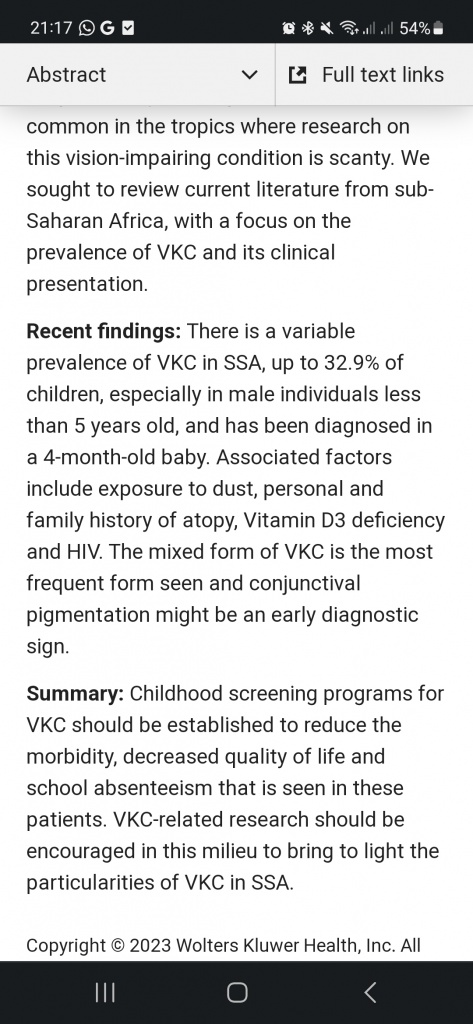It’s prevalence in children is around 30% according to the review. It definutely makes sense to screen school children for this disease. But the question is… With what would you treat that in tropics?

Eye Diseases Seen in Sub-Saharan Africa
It’s prevalence in children is around 30% according to the review. It definutely makes sense to screen school children for this disease. But the question is… With what would you treat that in tropics?

An Entity, of which I was not aware…
The role of human immunodeficiency virus in the pathogenesis of vernal keratoconjunctivitis-like disease in adults: A demographic and epidemiological study
Indian J Ophthalmol. 2020 Aug;68(8):1551-1554. doi: 10.4103/ijo.IJO_1608_19.
Authors
Anine Kritzinger 1 , Anthony G Zaborowski 1 , Wilbert Sibanda 2 , Linda Visser 1
Affiliations
1 Department of Ophthalmology, University of KwaZulu-Natal, Durban, South Africa.
2 School of Mathematics, Statistics and Computer Science, University of KwaZulu-Natal, Durban, South Africa.
PMID: 32709773
PMCID: PMC7640813
DOI: 10.4103/ijo.IJO_1608_19
Free PMC article
Abstract
Purpose: The purpose was to identify and describe patients with new-onset vernal keratoconjunctivitis-like (VKC-like) disease after puberty.
Methods: The study consisted of two parts: a prospective observational descriptive study of patients with new-onset VKC-like disease, and a case-control study to determine the relationship of a CD4 count with VKC-like disease in adults, in the setting of human immunodeficiency virus (HIV). Patients were recruited between January 2016 and November 2017 from a Provincial Eye hospital, one of two large referral hospitals in KwaZulu-Natal, South Africa. Patients presenting to the eye clinic were screened and diagnosed at the Primary Eye Care Unit. Inclusion criteria: age 15 years and older with signs and symptoms of new-onset VKC-like disease. Exclusion criteria: a history of childhood atopic diseases, atopic keratoconjunctivitis and patients who declined HIV testing. Data collected included HIV status, CD4 count, antinuclear antibodies and total serum immunoglobulin E.
Results: Thirty-three patients were included; females n = 16 and males n = 17. The mean age at presentation was 32.45 ± 9.93 years, 95% CI = 28.94-35.97. Twenty-six patients (78.8%) were HIV positive, 95% CI (62-89). The proportion of HIV positive patients was statistically different from the HIV negative group, Chi-squared = 21.866, P value <0.0001. In the group of HIV positive patients, 72% were classified as immunodeficient according to their CD4 counts. An association was proven between severely immunodeficient patients and the risk of VKC-like disease (Chi-squared = 4.992, P value = 0.0255).
Conclusion: In this cohort, a statistically significant association was found between VKC-like disease in adults and an HIV positive status. This association calls for more research on the subject.
Keywords: Allergy; VKC-like disease in adults; immunocompromised; ocular manifestations of HIV; vernal keratoconjunctivitis.
The RCT published in Ophthalmology (https://pubmed.ncbi.nlm.nih.gov/30593775-a-randomized-controlled-trial-of-cyclosporine-a-cationic-emulsion-in-pediatric-vernal-keratoconjunctivitis-the-vektis-study/) showed significant quality of life and corneal fluoresceine staining score improvement in those patients with vernal keratoconjunctivitis treated with Ciclosporine A cationic emulsion 4 times daily in comparison with CsA CE 2x daily or placebo.
Useful findings. Vernal and atopic keratoconjunctivitides comprase a major burden in Sub-Saharan Africa, and the usual steroid medications bring not only the temporary relief, but also complications (steroid cataract and steroid glaucoma, not a pleasant thing in the very young age of those patients…).
The results were not a surprise. However, the other major difficukty in those countries is the availability and the cost of such eye drops. Both ciclosporin and f.e. tacrolimus are very not easy to procure.